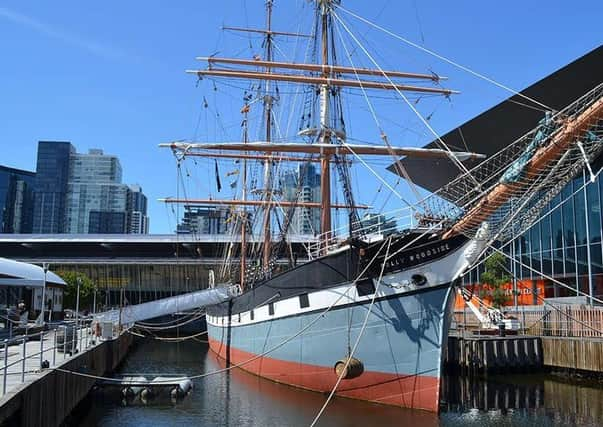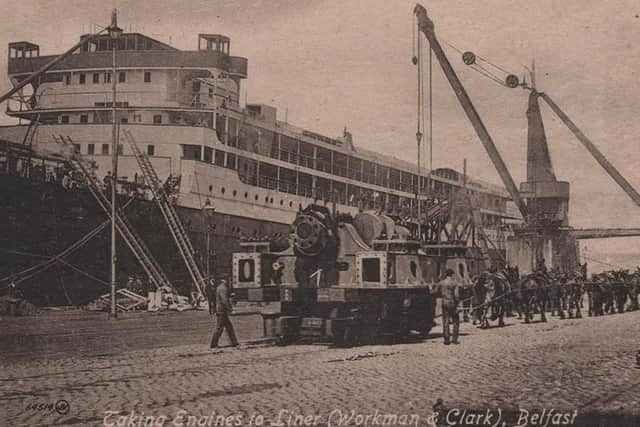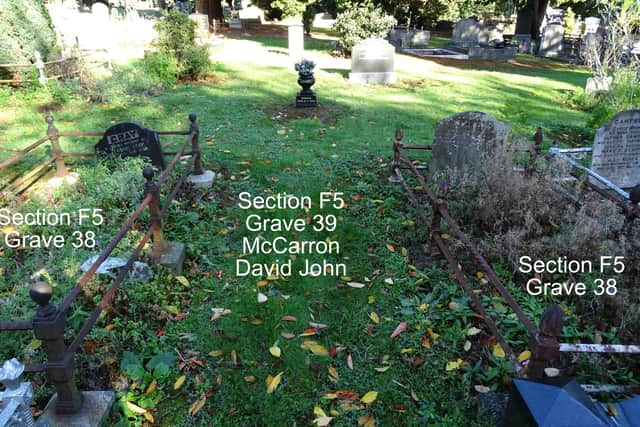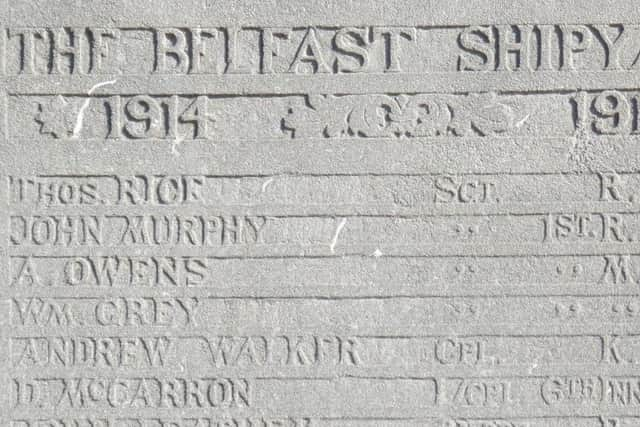East Belfast man recognised as war hero gets official gravestone


As a result of tireless work by researchers from the History Hub Ulster organisation, David John McCarron of Athens Street has been added to the Commonwealth War Graves Commission’s (CWGC) database of war fatalities 102 years after his death on July 4. 1918.
A red leader at the Workman Clark shipyard, David was a married man with one daughter when he enlisted for war service in October 1914.
Advertisement
Hide AdAdvertisement
Hide AdRed lead was the anti-corrosive paint applied to the hulls of ships to protect them against rust. It was highly toxic, one of the many health hazards faced by shipyard workers of yore.


David was 37 years old when he was deployed to France in October 1915 with the 6th (Inniskilling) Dragoons, the cavalry unit within the 36th (Ulster) Division.
Nigel Henderson, a researcher with History Hub Ulster, along with Brian Mooney and Maureen McKinney, has been researching the role played by Belfast’s Workman Clark shipyard in the war.
Formed in 1880 by former-H&W employees Frank Workman and George Clark, the company employed a workforce of around 3,500 by the 1900s, averaging 34,000 tons of ships per year.
Advertisement
Hide AdAdvertisement
Hide AdWWI was probably its peak output, with over 10,000 workers on its books and boasting the world record of 11,209 rivets hammered home by one man in one working day!


Coincidentally, one of the yard’s most famous ships is still afloat and was mentioned on this page just over a month ago.
Built and launched by Workman Clark in 1885, the multi-award-winning Polly Woodside Tall Ship and Museum in Melbourne was recently closed down due to Covid-19.
Regarded as one of the city’s most iconic and enchanting attractions since the late 1970s the three-mast, cargo vessel carried coal and wheat between England and South America and after travelling 1.7 million kilometres and circumnavigating the world 17 times, the Polly Woodside is now one of Australia’s most popular visitor attractions.
Advertisement
Hide AdAdvertisement
Hide AdWorkman Clark was jocularly nicknamed the ‘wee yard’ though it was actually one of the largest of the British shipbuilders and was only called ‘wee’ because Harland and Wolff was so big!


Nigel Henderson and his History Hub colleagues have been exploring the significant role played by Workman Clark in the Great War.
Nigel explained: “Whilst researching the names on the Belfast Shipyard memorial, I could not find an entry on the CWGC database for David.
“On searching through military records available online, I discovered that he had been evacuated back to Belfast after falling ill in May 1916.
“These records helped me to piece together David’s story.”
Advertisement
Hide AdAdvertisement
Hide AdAlthough still in the army, David returned to duties at Workman Clark, but his health continued to deteriorate.
In October 1917, he reported to the Military Hospital at Victoria Barracks with a range of symptoms.
On March 3, 1918, a medical board concluded that he was suffering from arterial degeneration with dilation of the heart which had been aggravated by his military service.
On April 4, 1918, McCarron was discharged as being permanently unfit for war service and was granted a pension.
Advertisement
Hide AdAdvertisement
Hide AdHe died of heart disease at Athens Street on July 4, 1918 and was buried in Dundonald Cemetery.
Nigel picks up the story. “The criteria for being classified as a war fatality includes situations in which discharged military personnel die of an illness caused by, or aggravated by, their military service,” explained Nigel.
“David John McCarron clearly satisfied the criteria and I submitted the documentation to the ‘In From the Cold Project’ (IFCP)”
On August 6, Nigel Henderson received confirmation that David’s case had been accepted and that his name had been added to the CWGC database.
Advertisement
Hide AdAdvertisement
Hide Ad“David may have lain in an unmarked grave for over a century,” said Nigel, “but he has now received the recognition to which he was due.”
Gavin Bamford, Chair of History Hub Ulster added: “Several of the society’s researchers have identified and submitted similar cases to the relevant authorities.
“Indeed, this is the third submission by Nigel to have been accepted in recent months and he has other submissions awaiting consideration.
“As a society, we feel it is important to ensure that forgotten war fatalities are properly recognised.
Advertisement
Hide AdAdvertisement
Hide Ad“More information about the process can be obtained from this website www.infromthecold.org and History Hub Ulster is more than happy to help to prepare submissions.”
Anne Osborne, one of David McCarron’s family circle, added: “I would like to thank Nigel Henderson and History Hub Ulster for the research and work involved in ensuring that Uncle Davy John (as he was referred to by my Grandmother) received this rightful recognition as a war fatality. The family is very proud of his service in the First World War and look forward to the installation of the headstone. It was only by chance that I came across Nigel’s appeal for David John’s relatives on a local history Facebook page and it was fascinating to hear more about him through Nigel’s very diligent research.”
Visit http://historyhubulster.co.uk for further information about the organisation.